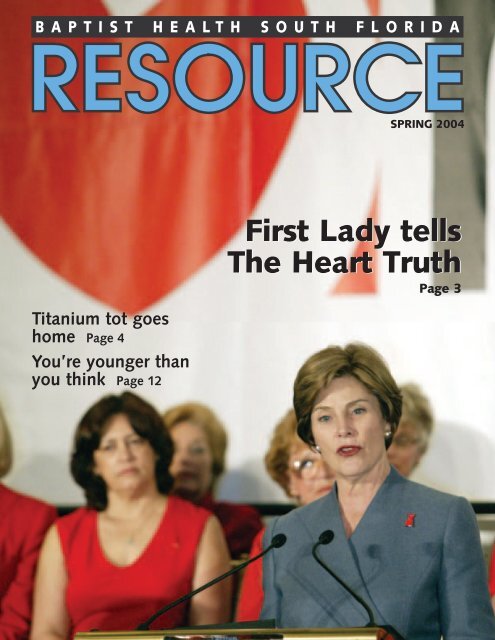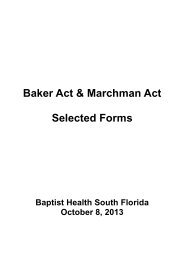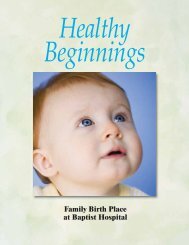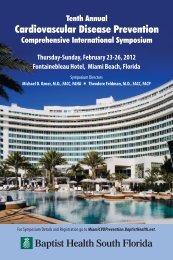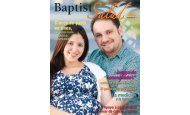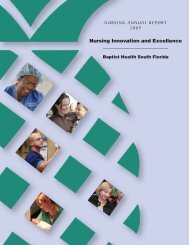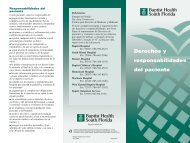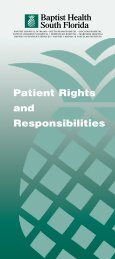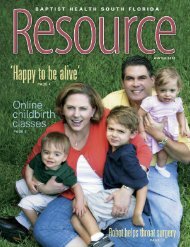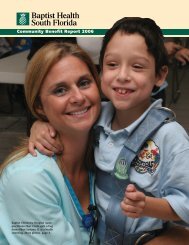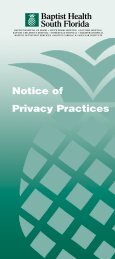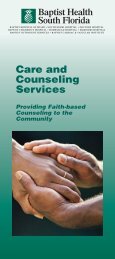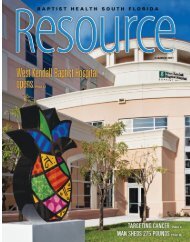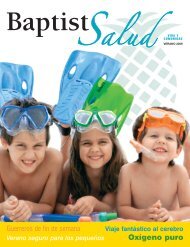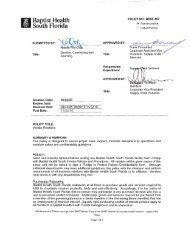Resource: Spring 2004 - Baptist Health South Florida
Resource: Spring 2004 - Baptist Health South Florida
Resource: Spring 2004 - Baptist Health South Florida
- TAGS
- baptist
- baptisthealth.net
You also want an ePaper? Increase the reach of your titles
YUMPU automatically turns print PDFs into web optimized ePapers that Google loves.
B A P T I S T H E A L T H S O U T H F L O R I D A<br />
Titanium tot goes<br />
home Page 4<br />
You’re younger than<br />
you think Page 12<br />
SPRING <strong>2004</strong><br />
First First Lady Lady tells tells<br />
The The Heart Heart Truth Truth<br />
Page 3
W hether<br />
MANPOWER:<br />
A game plan for health<br />
Saturday, May 8, 8:30 a.m.-1 p.m.<br />
you’re tackling football players, sales quotas or household chores, you need to keep yourself in the best<br />
possible shape. From the early warning signs of a heart attack to the first signs of a receding hairline, your body<br />
is constantly sending out signals. Learn to get the signals straight and develop a game plan for health<br />
at a free program featuring former Miami Dolphins quarterback Don Strock and a panel of medical experts<br />
from <strong>Baptist</strong> <strong>Health</strong>.<br />
Dr. Epstein<br />
8:30 a.m. Registration and continental breakfast<br />
9 a.m. Winning Strategies: Keys to a <strong>Health</strong>y Lifestyle.<br />
Don Strock, head football coach at <strong>Florida</strong> International<br />
University and former Miami Dolphins quarterback.<br />
9:30 a.m. Physician Panel Discussion<br />
Stay at the Top of Your Game: Preventing and<br />
Treating Sports Injuries. Sports medicine specialist<br />
Don Strock<br />
Harlan Selesnick, M.D.<br />
How to Play It: New Techniques to Treat Prostate Cancer.<br />
Radiation oncologist Steven Olszewski, M.D.<br />
Tackling Hair Loss. Hair transplant specialist Jeffrey Epstein, M.D.<br />
Play It Smart: Preventing Heart Disease. Cardiologist Theodore Feldman, M.D.<br />
11 a.m.- Extra Points. Free screenings for cholesterol, diabetes, blood pressure and leg<br />
Dr. Feldman 1 p.m. blood flow (peripheral vascular screening). Also, “Ask the Experts” with fitness<br />
specialists and registered dietitians on hand to answer questions.<br />
Enjoy exhibits and healthy snacks. Men — and the women who love them — are invited to this free event.<br />
Reservations are required. Call 786-596-2871.<br />
<strong>Baptist</strong> <strong>Health</strong> <strong>South</strong> <strong>Florida</strong> Chairman of the Board, George E. Cadman III; President, Brian E. Keeley.<br />
Trustees: Wendell R. Beard, H. Robert Berry Sr., James Carr, the Rev. William L. Chambers, the Rev.<br />
David W. Cleeland, George Corrigan, William H. Dickinson, Judge Robert L. Dubé, Herbert Greene,<br />
M.D., George Harth, Jay A. Hershoff, Charles Hood III, Norman Kenyon, M.D., the Rev. Richard<br />
Ledgister, the Rev. Wilner Maxy, Paul May, Arva Parks McCabe, the Rev. Dr. Marcos Ramos, the Rev.<br />
Dr. Emit O. Ray, Robert Singleton, Roberta Stokes, W. Peter Temling, the Rev. Tom Thompson, Scott<br />
Weston, the Rev. Dr. William W. White.<br />
<strong>Baptist</strong> Hospital of Miami Chairman of the Board, the Rev. Dr. Emit O. Ray; President, <strong>Baptist</strong> Hospital<br />
Medical Staff, Sergio Gonzalez-Arias, M.D.; Chief Executive Officer, Lee Huntley. Hospital Directors:<br />
Luis Ajamil, Calvin H. Babcock, H. Robert Berry Sr., A. Ruben Caride, M.D., the Rev. David W. Cleeland,<br />
Sergio Gonzalez-Arias, M.D., Charles Hood III, S. Lawrence Kahn III, Pamela Larcada, M.D., Manuel<br />
Lasaga, Paul May, the Rev. Tom Thompson, the Rev. Dr. William W. White, Philip Wolman.<br />
<strong>South</strong> Miami Hospital Chairman of the Board, Judge Robert L. Dubé; President, <strong>South</strong> Miami Hospital<br />
Medical Staff, George Tershakovec, M.D.; Chief Executive Officer, D. Wayne Brackin. Hospital Directors:<br />
Yerby Barker, Jill Beach, George Corrigan, Allan Feingold, M.D., Michael Graham, M.D., Elizabeth<br />
Hernandez, Nathan Hirsch, M.D., Orlando Leon, M.D., James Loewenherz, M.D., Hans Mueller, Ian<br />
Reiss, M.D., Domingo Rodriguez, W. Peter Temling, George Tershakovec, M.D., Joseph Traina, M.D.,<br />
Scott Weston, Leonard Zwerling, M.D.<br />
Homestead Hospital Chairman of the Board, the Rev. William L. Chambers III; Chief of Staff, J.<br />
Rudolph Gossman Jr., DMD; Chief Executive Officer, Bo Boulenger. Hospital Directors: Wendell Beard,<br />
2 RESOURCE<br />
BAPTIST<br />
<strong>South</strong> Miami Hospital<br />
Victor E. Clarke Education Center • U.S. 1 and SW 62 Avenue<br />
Visit us at www.baptisthealth.net.<br />
6855 Red Road, Suite 600<br />
Coral Gables, FL 33143-3632<br />
Dr. Olszewski<br />
Dr. Selesnick<br />
Willie Carpenter, J. Rudolph Gossman Jr., DMD, David Hallstrand, M.D., Barbara Hanck, Carl Hanson,<br />
Ramon Oyarzun, Steven Sapp.<br />
Mariners Hospital Chairman of the Board, Jay A. Hershoff; Chief of Staff, Stanley Zuba, M.D.; Chief<br />
Executive Officer, Robert H. Luse. Hospital Directors: Blake Bush, William H. Dickinson, Gerald Hirsch,<br />
David Johnson, Louise Orzel, Charlen Regan, Chris Schrader, I.E. Schilling, Stanley Zuba, M.D.<br />
Doctors Hospital Chairman of the Board, Norman Kenyon, M.D.; President, Doctors Hospital Medical<br />
Staff, Jack Cooper, M.D.; Chief Executive Officer, Lincoln Mendez. Hospital Directors: Tony Alonso,<br />
James Barker, H. Robert Berry Sr., Robert Breier, Jack Cooper, M.D., George Knox, Miriam Lopez, Arva<br />
Parks McCabe, Ramón Rasco, Ronald Shuffield, Karl Smiley, M.D., Roberta Stokes, Henry Tie Shue,<br />
Lisa G. White.<br />
<strong>Baptist</strong> <strong>Health</strong> <strong>South</strong> <strong>Florida</strong> Foundation Chairman of the Board, James Carr; Chief Executive Officer,<br />
Robert G. Baal. Directors: Richard T. Alger, Cira Almeida, George Aronoff, Oscar Barbara, Yerby Barker,<br />
Rodney Barreto, H. Robert Berry Sr., James Boilini, O.D., James Bokor, Joseph Bolton, James<br />
Boruszak, Bette Brown, Barbara Calev, Thomas Carlos, Gerald Case, John Cassel, M.D., Mauricio<br />
Cayon, Carol Cianciolo, Jack Cooper, M.D., Richard Dailey, Xavier de Amezola, William H. Dickinson,<br />
Mehdi Ghomeshi, Robert Gintel, Sergio Gonzalez-Arias, M.D., J. Rudolph Gossman Jr., DMD, Curtis<br />
Gray, Lisa Greer, Roger Gunderson, DDS, Kent Hamill, Barbara Hanck, Dan Hanrahan, James Harris,<br />
Steven Hayworth, Agustin Herran, Jay Hershoff, Gerald Hirsch, Rudy Kranys, Cynthia Leesfield,<br />
Michael Marcus, Charlie Martinez, Thomas P. Murphy Jr., Omar Pasalodos, M.D., Gordon Present,<br />
Mindy Rich, Ron Robinson, Audrey Ross, James F. Russell, George Tershakovec, M.D., Henry Tie<br />
Shue, Paul Soulé, Bill R. Tillett, Barbara Towner, Wanda Trouba, Frederick Vihlen, M.D., Stuart Weiss,<br />
Philip Wolman, Stanley Zuba, M.D.<br />
<strong>Baptist</strong> Outpatient Services Chairman of the Board, George E. Cadman III; Chief Executive Officer,<br />
Patricia M. Rosello. Directors: Tony Alonso, H. Robert Berry Sr., Oscar Bustillo Jr., the Rev. David W.<br />
Cleeland, Charles Hood III, Alfredo Quintero, the Rev. Dr. Emit O. Ray, Ronald Shuffield, Paul Soulé,<br />
Roberta Stokes, Scott Weston.
First Lady’s message:<br />
Heart attacks kill women<br />
In the United States this year, 65,000<br />
more women than men will die from<br />
heart attacks. That’s right — women.<br />
And that’s the message that First Lady<br />
Laura Bush pledged to spread when she<br />
visited <strong>Baptist</strong> Hospital in February to<br />
speak to female heart disease survivors<br />
and healthcare workers.<br />
Mrs. Bush’s visit coincided with the<br />
release of new women’s heart guidelines<br />
by the American Heart Association. The<br />
guidelines emphasize lifestyle changes<br />
to prevent heart attack, but also call for<br />
aggressive use of medications in highrisk<br />
women.<br />
The Heart Association said women<br />
should receive treatment based on risk<br />
for a heart attack. A high-risk woman<br />
has already had a heart attack, or a<br />
stroke, or has diabetes. A moderate-risk<br />
woman may have high cholesterol and<br />
high blood pressure. A low-risk woman<br />
is healthy and within normal ranges for<br />
weight, cholesterol and blood pressure.<br />
Aspirin therapy, ACE inhibitors and<br />
beta-blockers are recommended for<br />
women in the high-risk category. Aspirin<br />
therapy and drugs to lower cholesterol<br />
and blood pressure should be consid-<br />
ered for the woman at moderate risk.<br />
(See related story on page 10.)<br />
“In America,” Mrs. Bush said, “one<br />
woman dies each minute from heart disease.<br />
Heart disease kills more women<br />
than all forms of cancer combined. I urge<br />
you to get your cholesterol, your blood<br />
pressure and your blood sugar checked.<br />
Everyone needs to know that heart disease<br />
is the number-one killer of women.”<br />
As Mrs. Bush spoke to the crowd,<br />
18 women, heart disease survivors,<br />
sat behind the podium.<br />
They wore red in honor of The Red<br />
Dress, the symbol of The Heart Truth, a<br />
national campaign to raise awareness of<br />
women’s heart disease.<br />
Mrs. Bush lauded the group’s efforts<br />
to exercise, lose weight and quit smoking.<br />
“If my mother-in-law, Barbara Bush,<br />
can swim 88 laps at a time, then you can<br />
walk 30 minutes,” she said. “There’s one<br />
absolute when it comes to exercise: Any<br />
is better than none.” The First Lady<br />
walks at least three times a week and<br />
also lifts weights.<br />
“Mrs. Bush is a terrific role model,”<br />
said Pat Stephenson Cook, a professor at<br />
Miami-Dade College and part of the<br />
Women&<strong>Health</strong><br />
Annie de Velasco (at podium) is applauded by fellow heart disease survivors after telling her story. Also speaking at<br />
The Heart Truth event at <strong>Baptist</strong> Hospital were First Lady Laura Bush (right), <strong>Baptist</strong> <strong>Health</strong> CEO Brian Keeley and<br />
cardiologist Abbe Rosenbaum, M.D. (front row, far left.)<br />
heart survivor group. “She’s very fit and<br />
shows a genuine concern for the issue.”<br />
Ms. Stephenson Cook had a heart attack<br />
two years ago.<br />
“<br />
It’s a subject that needs attention, and<br />
it was very comforting to hear the<br />
First Lady talk about it,” said Esther<br />
Arango. “When I had a heart attack 12<br />
years ago, there was no information<br />
available about women and heart disease.<br />
We’ve made a lot of progress in<br />
those 12 years, but thanks to Mrs. Bush,<br />
more improvements will be coming.”<br />
Mrs. Bush emphasized the importance<br />
of seeing a doctor to learn your<br />
risk factors. “The doctors, nurses and<br />
staff make <strong>Baptist</strong> Cardiac & Vascular<br />
Institute a national center of excellence<br />
for cardiac disease,” she said. “The best<br />
prevention is education.”<br />
Cardiologist Abbe Rosenbaum, M.D.,<br />
agreed, telling the audience that when a<br />
woman has a heart attack, she may not<br />
experience the crushing chest pain most<br />
men report. “The symptoms can be different,<br />
which is one of the reasons<br />
women are more likely than men to die<br />
from their first heart attack.”<br />
— Adrienne Sylver<br />
RESOURCE 3
Titanium tot goes home<br />
Kaylee Holler is a bionic baby,<br />
breathing on her own and happily<br />
living at home after doctors at<br />
<strong>Baptist</strong> Children’s Hospital gave her<br />
something she was born without — half<br />
a rib cage.<br />
Kaylee was two months premature,<br />
weighing 3 pounds, 71/2 ounces when<br />
she was born Aug. 24 at Homestead<br />
Hospital. She was transferred to <strong>Baptist</strong><br />
Children’s Hospital and put on a respirator<br />
when doctors discovered her rare<br />
birth defect known as Poland Syndrome.<br />
Six of the ribs on the left side of her body<br />
were missing, among other problems.<br />
As a result, her chest caved in when she<br />
tried to breathe.<br />
“She would stop breathing every<br />
day,” her mother, Mitzi Holler, recalled.<br />
“I didn’t think she was going to<br />
make it.”<br />
Her tiny size made surgery a challenge.<br />
But with input from specialists at<br />
Johns Hopkins University in Baltimore,<br />
pediatric surgeons Juan Sola, M.D., and<br />
Donald Buckner, M.D., figured out a way<br />
to fashion the front half of the rib cage<br />
out of titanium mesh.<br />
At 7 weeks old, Kaylee had the operation.<br />
About a month later, she went<br />
home to her family, parents Mitzi and<br />
Michael Holler, and big sister Kelsey<br />
King, 10.<br />
<strong>Baptist</strong> Children’s Hospital is moving its outpatient<br />
rehabilitation center to a new location with easy<br />
access, plenty of parking and a full staff of therapists<br />
and social workers. The<br />
Martha Ware RehabilitationCenter,<br />
named<br />
after benefactor<br />
Martha<br />
Ware, is<br />
located at<br />
9035 Sunset<br />
Drive.<br />
4 RESOURCE<br />
By the new year, Kaylee had grown<br />
to more than 9 pounds and was doing<br />
well. She’ll need several more operations<br />
as she grows.<br />
Pediatric radiologists Amy Cantor,<br />
M.D., and Jonathan Fields, M.D.,<br />
examine images showing Kaylee’s<br />
missing ribs. Kaylee (inset) and her<br />
parents are happily at home.<br />
Children’s center moves<br />
“I can’t believe everything that’s<br />
happened,” Ms. Holler said. “I’m so<br />
happy.”<br />
— Patty Shillington<br />
“We are so grateful for Ms. Ware’s support in making this<br />
happen,” said Randall Lee, <strong>Baptist</strong> Children’s Hospital administrator.<br />
“She’s a generous philanthropist who wanted to help<br />
disabled and developmentally delayed children get the help<br />
they need.”<br />
With its kid-friendly decor, the Center is sure to put children<br />
at ease. The Center serves children who need physical,<br />
occupational and speech therapy, including babies and youngsters<br />
with developmental delays, spina bifida and cerebral<br />
palsy. In addition, therapists work with children who have<br />
had strokes or brain injuries, and those with feeding or swallowing<br />
problems. Children who stutter or have other speech<br />
problems see a speech therapist. For more information, call<br />
786-596-5188.
Let’s get jumping, girls!<br />
For girls, a little high-impact exercise can go a long way toward keeping<br />
bones strong later in life, a study has found. Girls approaching puberty<br />
who strengthened their legs and back with<br />
jumping exercises increased their bone mass<br />
by 5 percent, researchers at the University of<br />
British Columbia discovered. That’s the<br />
equivalent of three to five years of postmenopausal<br />
bone loss.<br />
In the study, published in the journal<br />
Pediatrics, fourth- through sixth-grade girls<br />
jumped for 10 minutes three times a week during<br />
two 10-month school years. A follow-up<br />
study showed similar benefits when girls<br />
jumped as few as five times three times a day.<br />
Day of Smiles<br />
Jawaan Sanders, 8, jokes with anesthesiologist Vincent Conte, M.D., before<br />
his surgery.<br />
For a year, 8-year-old Jawaan Sanders lived not only with the memory of his<br />
mother’s abuse, but also the deep long burn scar on his right cheek,<br />
caused by a curling iron. But today when the boy looks in the mirror, it’s a<br />
healing grin he sees on his face.<br />
The scar was surgically removed for free last November by plastic surgeon<br />
Jhonny Salomon, M.D., during the Day of Smiles at <strong>Baptist</strong> Children’s<br />
Hospital. The hospital and 30 doctors, nurses, technicians and other staff volunteered<br />
their services to correct facial deformities for four children and one<br />
adult who could not afford the operations.<br />
It was <strong>Baptist</strong> Children’s Hospital’s third Day of Smiles. In all, 21 children<br />
and young adults have received free surgery since the program began. And it’s<br />
not just the kids who end up feeling better.<br />
Plastic surgeon Joel Levin, M.D., gets “instant gratification” from being<br />
able to make a profound difference in a child’s life with one short operation.<br />
Plastic surgeons Michael Kelly, M.D., Brad Herman, M.D., and Phillip Craft,<br />
M.D., and oral surgeon Joseph McCain, DMD, also participated.<br />
BAPTIST CHILDREN’S HOSPITAL<br />
PRESENTS<br />
Join the parenting experts at <strong>Baptist</strong><br />
Children’s Hospital for enlightening conversation<br />
and practical advice. Each program is<br />
held in the auditorium at <strong>Baptist</strong> Hospital<br />
and costs $5. You must reserve your space<br />
by calling 786-596-3812.<br />
How Parents Influence<br />
Eating and Exercise<br />
Thursday, March 25, 7-9 p.m.<br />
Overweight children often become<br />
young adults with major health problems.<br />
Join psychologist Joseph Mora, Ph.D., and<br />
registered dietitian Karla Otero as<br />
they offer you tips on raising<br />
healthy children. They’ll discuss<br />
modeling good eating habits,<br />
making wise food choices, the<br />
pros and cons of restricting<br />
foods and finding time<br />
for exercise. For<br />
parents of kids<br />
ages 3 to 12.<br />
The Unfocused Child<br />
Thursday, April 22, 7-9 p.m.<br />
When your child can’t pay attention,<br />
you’ve got a problem. Learn about ADD and<br />
ADHD symptoms, diagnosis and treatment<br />
from mother and son team Sally Kolitz-<br />
Russell, Ph.D., and Brent Kolitz, Ph.D. For<br />
parents of young children and teens.<br />
Sensory Integration Problems<br />
Thursday, May 27, 7-9 p.m.<br />
Some young children have difficulty with<br />
tasks such as buttoning or using scissors.<br />
Others are bothered by loud noises or certain<br />
fabrics touching their skin. If you have<br />
a child with sensory integration problems,<br />
join occupational therapist Tania Fernandez<br />
of <strong>South</strong> Miami Hospital’s Child Development<br />
Center as she teaches you how to help<br />
your child cope. For parents of children ages<br />
4 to 10.<br />
BAPTIST<br />
<strong>Baptist</strong> Children’s Hospital<br />
8900 North Kendall Drive<br />
RESOURCE 5
<strong>Baptist</strong> Cardiac & Vascula<br />
AMAZING! That’s the reaction I had when I read writer Sandy Baksys’ stories about new ways to prevent<br />
and treat strokes, advances in the treatment of aneurysms, as well as the latest information on how heart<br />
disease affects women and people with diabetes. <strong>Baptist</strong> Cardiac & Vascular Institute (formerly Miami<br />
Cardiac & Vascular Insitute) has pioneered new treatments in cardiovascular disease since it opened in 1987.<br />
But equally important is its mission of prevention, education and clinical research. We hope you’ll find these<br />
stories informative...and for some of our readers, even life-saving.<br />
—-The Editor<br />
Carotid stents prevent strokes<br />
William Cohen, 61, was on the road to a stroke when<br />
doctors at <strong>Baptist</strong> Hospital opened a blocked artery<br />
in his neck with angioplasty and a stent instead of<br />
surgery.<br />
“I was really grateful that they caught this in time, that I didn’t<br />
have a stroke and I didn’t have surgery, either,” said Mr. Cohen,<br />
who owns a small freight forwarding company in Coral <strong>Spring</strong>s.<br />
When Mr. Cohen was diagnosed with a 92 percent blockage<br />
in one of the carotid arteries in his neck, his doctor recommended<br />
a surgery called endarterectomy. Surgery prevents<br />
strokes by removing plaque in the artery that can shed<br />
clots and other fatty particles directly into the brain.<br />
But Mr. Cohen wanted an alternative. He sought an expert<br />
opinion at <strong>Baptist</strong> Cardiac & Vascular Institute, where he<br />
entered a clinical research trial of carotid angioplasty and stenting.<br />
Both procedures have been used for years in the heart.<br />
But they pose special challenges in the neck because physicians<br />
are working so close to the brain.<br />
For example, even before Mr. Cohen’s angioplasty could<br />
begin, a tiny, removable umbrella had to be positioned inside<br />
his carotid artery, downstream from his blockage, to trap any<br />
fatty debris that could come loose and cause a stroke.<br />
And, unlike heart stents implanted deep within the body,<br />
carotid stents need to be flexible and uncrushable as the neck<br />
bends and twists and is touched and pressed. Today’s carotid<br />
stents are made of a special material called nitinol, which holds<br />
its shape at body temperature.<br />
before after<br />
A dramatic difference can be seen after a blocked carotid<br />
artery (left) is propped open with a stent (right) to restore<br />
blood flow to the brain.<br />
6 RESOURCE<br />
A tiny, removable umbrella is placed inside the carotid<br />
artery to catch any debris that could break loose and cause<br />
a stroke.<br />
The first such stent is expected to be approved by the FDA<br />
this year. Soon afterward, the Institute will become a training<br />
center for other physicians who want to learn how to use it.<br />
That’s because Institute physicians have played a leading,<br />
national role in the development and testing of carotid stents.<br />
Barry Katzen, M.D., the Institute’s founder and medical director,<br />
helped organize one of the first national studies demonstrating<br />
that carotid stenting is equal to surgery in preventing<br />
strokes, with fewer serious complications.<br />
Until stents were developed to open carotid arteries, surgery<br />
was the only preventive treatment. “Surgery has<br />
long been the gold standard for preventing stroke, and<br />
we expect it to continue to be an important option for patients<br />
with advanced carotid disease,” said Jose Alvarez, M.D., the<br />
Institute’s chief of vascular surgery.<br />
For those who choose surgery, the Institute’s outcomes are<br />
outstanding: serious complications after carotid surgery are 50<br />
percent lower than American Heart Association guidelines.<br />
Now the Institute is participating in clinical research sponsored<br />
by the National Institutes of <strong>Health</strong>. “What’s exciting<br />
about this new research is that it enlists hundreds of the most<br />
skilled physicians across the country,” Dr. Katzen said. “We<br />
already know that stenting is less invasive than surgery. Now<br />
we will learn which procedure actually protects better against<br />
strokes in patients with advanced carotid disease.” ♥
Institute Update<br />
Buddy Connors, M.D., uses catheters the size of angel hair pasta to open up blocked blood vessels in the brain that can<br />
cause a stroke. He is assisted by Richard Harp, M.D., (left).<br />
ER stroke team saves lives<br />
Every year, more than 800 stroke patients come through<br />
the doors of <strong>Baptist</strong> Hospital, making it one of the busiest<br />
stroke centers in the state. Today, patients in a race<br />
against the clock to stop their stroke and restore blood flow to<br />
the brain are met by <strong>Baptist</strong>’s Emergency Stroke Team.<br />
The team swings into action as soon as the Emergency Center<br />
is notified that a stroke patient is on the way, according to neurologist<br />
Paul Damski, M.D., medical director of <strong>Baptist</strong> Hospital’s<br />
Stroke Program. A neurology nurse rushes to the ER to assist<br />
physicians there in assessing the stroke’s type and magnitude.<br />
An on-call brain specialist may then be summoned to perform<br />
one of a whole new arsenal of emergency stroke treatments.<br />
Rafael Marino, 69, of Puerto Rico, was visiting his sister in<br />
Kendall when he suffered a life-threatening blockage in a<br />
major artery feeding his brain. “Luckily, he and my mother<br />
were just getting into the car to go out when he suddenly<br />
started shaking and twisting,” said Esperanza Perez, Mr.<br />
Marino’s niece.<br />
Due to his quick arrival at <strong>Baptist</strong>, Mr. Marino received<br />
intravenous tPA, a clot-busting drug that is effective only for<br />
several hours after a stroke begins. Only 5 percent of stroke<br />
patients are able to receive tPA due to the usual delay in recognizing<br />
symptoms and getting the patient to a hospital.<br />
In Mr. Marino’s case, however, tPA circulating throughout<br />
his body didn’t provide enough clot-buster directly to the<br />
stroke site. So much of the clot remained that it continued to<br />
constrict blood flow to the brain.<br />
What happened next demonstrates just how far stroke<br />
treatment has advanced in recent years, according to Buddy<br />
Connors, M.D., medical director of interventional neuroradiology<br />
at <strong>Baptist</strong> Cardiac & Vascular Institute. Using a catheter<br />
threaded through an artery into Mr. Marino’s brain, Dr. Connors<br />
delivered clot-busting drugs directly to the blockage causing<br />
the stroke.<br />
Within about a day of his arrival at <strong>Baptist</strong>, Mr. Marino<br />
also underwent angioplasty to flatten plaque that still partially<br />
blocked the artery where the stroke had occurred. According<br />
to Dr. Connors, fatty plaque often underlies a stroke-causing<br />
clot and must also be cleared.<br />
Used in the heart for many years, today angioplasty in the<br />
brain is giving new hope to stroke patients and their families.<br />
Several months after his successful treatment, Mr. Marino<br />
passed a follow-up exam at <strong>Baptist</strong> Hospital and returned<br />
home to Puerto Rico with no stroke-related disabilities.<br />
“That’s a major win because stroke is the third-leading cause<br />
of death and the leading cause of disability in the United<br />
States,” Dr. Connors said.<br />
Coming soon are even newer technologies to remove<br />
stroke-causing clots. For example, <strong>Baptist</strong> physicians will soon<br />
use a small corkscrew device mounted on a catheter to remove<br />
large portions of blood clots in the brain, making it easier for<br />
drugs to dissolve the parts that remain.<br />
Just like angioplasty, most new treatments will be non-surgical,<br />
allowing doctors to travel the body’s own arterial “highways”<br />
to reach the stroke site.<br />
“With new catheter-based technologies, we are looking at<br />
the opportunity to reach and treat almost any kind of blockage<br />
in any artery in the brain,” Dr. Connors said. ♥<br />
RESOURCE 7
<strong>Baptist</strong> Cardiac & Vascula<br />
Aneurysm patients make history<br />
Harlan Twible survived the sinking of the USS Indianapolis<br />
and five endless days in Pacific shark-infested<br />
waters where 880 crewmen perished in the waning<br />
days of World War II.<br />
“I was a 23-year-old ensign just out of the Naval Academy,<br />
but I was the only officer in the water, responsible for all those<br />
lives,” Mr. Twible recalled.<br />
At 82, Mr. Twible is again helping to write history. Almost<br />
six years ago at <strong>Baptist</strong> Cardiac & Vascular Institute, a device<br />
called a stent-graft was placed in his aorta to treat a life-threatening<br />
aneurysm.<br />
Mr. Twible’s stent-graft immediately stabilized his<br />
aneurysm and kept it from bursting. Even more remarkable,<br />
his implant protects him today and is expected to do so for the<br />
foreseeable future. In this respect, Mr. Twible joins hundreds<br />
of other Institute patients who have received stent-grafts over<br />
the past decade.<br />
“With a 10-year track record now behind us, we know that<br />
stent-grafts are durable and offer long-term protection against<br />
fatal aneurysm rupture,” said Barry Katzen, M.D., founder<br />
and medical director of the Institute.<br />
Mr. Twible had a 2.5-inch aneurysm in the aortic artery<br />
supplying blood to the entire lower half of his body. He knew<br />
the stretched and weakened vessel in his abdomen could burst<br />
at any time, killing him in<br />
minutes.<br />
After a nationwide search,<br />
Mr. Twible came to the Institute<br />
for intensive testing that<br />
qualified him for a clinical<br />
trial of a new stent-graft.<br />
Gary Becker, M.D., Mr.<br />
Twible’s doctor and assistant<br />
medical director of the Institute,<br />
threaded a catheter<br />
An MRI shows a ballooning<br />
aneurysm in the aorta, the<br />
main artery that carries blood<br />
from the heart to the rest of<br />
the body.<br />
8 RESOURCE<br />
through an artery in the<br />
groin up to the aneurysm site<br />
just below Mr. Twible’s<br />
kidneys.<br />
The catheter was used to<br />
implant the stent-graft, a fab-<br />
ric and metal tube that channels blood through the weakened<br />
section of the artery.<br />
“When blood flows through the stent-graft and not through<br />
the aneurysm, that relieves pressure and prevents the<br />
aneurysm from bursting,” Dr. Becker explained.<br />
The Institute was among the first five research centers in<br />
the United States to use abdominal aortic stent-grafts in 1994.<br />
Since then, Institute doctors have placed hundreds in carefully<br />
selected patients, with far fewer deaths and complications<br />
than surgery.<br />
As stent-graft technology advances, the Institute is con-<br />
Sarasota resident Harlan Twible wasn’t a candidate for<br />
surgery for his aortic aneurysm, but a stent-graft keeps it<br />
from bursting.<br />
ducting new research on devices for the section of the aortic<br />
artery passing through the chest. Dr. Katzen also recently<br />
became the second physician in the nation to implant an experimental<br />
stent-graft that can be threaded through the smaller<br />
arteries in women.<br />
Best of all, Dr. Katzen noted, stent-graft research has produced<br />
a growing portfolio of devices. “No two abdominal<br />
aortic aneurysms are the same, and one stent-graft does<br />
not fit all patients,” he explained. “Our participation in so many<br />
successful studies ensures that we will be able to offer at least<br />
one device to the majority of patients.”<br />
Mr. Twible returns to the Institute every year from his<br />
home in Sarasota to make sure his device is still in place<br />
and not leaking, and that his aneurysm — which once bulged<br />
with blood under high pressure — remains a limp and<br />
empty sac. Mr. Twible said he considers the protection<br />
he has received without grueling surgery well worth his<br />
hospital visits.<br />
“As a person who had four heart attacks and was 75 years<br />
old, I was a poor risk for conventional surgery,” Mr. Twible<br />
said. “My stent-graft has given me almost six eventful years<br />
of life.” ♥
Institute Update<br />
Even a kid can get fit<br />
By first grade, 6-year-old Amber Balda weighed 89 pounds, showed early signs of diabetes<br />
and had trouble finding friends at school. That’s when her mother, Monica<br />
Balda, entered Amber in a special program at <strong>Baptist</strong> Hospital for people of all ages<br />
who are at risk for diabetes and heart disease.<br />
Amber learned better eating habits and even asked to join Kid Fit, another <strong>Baptist</strong> program<br />
where she began exercising for one hour, three times a week after school.<br />
Some might say that 6 is too young to have a lifestyle, much less a lifestyle change. But in<br />
just three months, Amber was both a happier and healthier little girl, Ms. Balda said.<br />
Amber’s story only goes to prove you’re never too young or too old to adopt a healthy<br />
lifestyle, said Lois Exelbert, R.N., director of <strong>Baptist</strong>’s Diabetes Care Center.<br />
Amber Balda, 6, exercises three<br />
For information on the risk reduction program, call 786-596-8747. For information about times a week after school in<br />
Kid Fit, call 786-596-2424. ♥<br />
<strong>Baptist</strong>’s Kid Fit program. Photo:<br />
Helping hearts keep the beat<br />
The average human heart beats more than 100,000 times<br />
each day. But what may sound to you like a single heartbeat<br />
is really a series of smaller contractions that move<br />
blood through the four chambers of the heart and the lungs<br />
before pumping it to the farthest corners of your body.<br />
Unfortunately, disease can short-circuit the delicate electrical<br />
system that coordinates the heart’s contractions.<br />
After a major heart attack, a person may suddenly develop<br />
irregular, fast heartbeats called tachycardia, which can<br />
progress to fibrillation, an uncontrolled quivering that makes<br />
the heart stop pumping altogether. When the heart’s main<br />
pumping chamber, the left ventricle, goes into fibrillation and<br />
stops, the victim suffers cardiac arrest.<br />
If an external defibrillator isn’t applied to the chest to shock<br />
the heart back into action in five or six minutes, a person in cardiac<br />
arrest may die. Such defibrillators can now be found in<br />
many public places, from health clubs to airplanes.<br />
Today there are also computer-controlled defibrillators that<br />
can go everywhere a patient goes since they’re small enough to<br />
be implanted under the skin of the chest. These implantable cardioverter<br />
defibrillators (ICDs) can detect the beginning of a<br />
too-fast heartbeat and automatically administer a small electric<br />
shock through one or more small wires threaded into the heart.<br />
“ICDs are an extremely effective insurance policy for<br />
heart attack survivors who might, at any time, go into cardiac<br />
arrest,” said Efrain Gonzalez, M.D., medical director of<br />
electrophysiology at <strong>Baptist</strong> Cardiac & Vascular Institute.<br />
“Every year, they prevent thousands of deaths.”<br />
Patients whose hearts can’t pump as much blood as they<br />
should are at a higher risk of cardiac arrest, Dr. Gonzalez<br />
explained. Under new guidelines, Medicare will now pay for<br />
such patients to receive an implantable defibrillator. Under the<br />
old guidelines, only about one in five patients who might be<br />
protected by an ICD actually got one.<br />
About 650,000 Americans have first-time heart attacks each<br />
How it works<br />
All heart rhythm devices use miniature computer<br />
technology and are battery-powered. The main unit,<br />
containing a microprocessor and batteries, is implanted just<br />
under the skin in the upper chest. This unit both monitors<br />
the heart’s rhythms and generates small pulses of electricity.<br />
The pulses travel down wires, called leads, that are threaded<br />
into chambers of the heart at the same time that the main<br />
unit is implanted.<br />
year. Close to 433,000 survive. Of those, at least 43,000, or 10<br />
percent, have a pumping volume, or ejection fraction, of 30<br />
percent or less — low enough to qualify for an ICD.<br />
“This should encourage more survivors to go to their doctor<br />
and find out what their ejection fraction is, and to discuss<br />
whether they need an ICD in addition to anti-arrhythmia<br />
drugs,” Dr. Gonzalez said.<br />
Anew type of implantable pacemaker is also improving<br />
prospects for heart failure patients. Traditional pacemakers<br />
speed up slowing hearts by sensing when<br />
there’s a missed beat and sending out pulses of electricity so<br />
tiny they can’t be felt. The new pacemaker for heart failure,<br />
called a cardiac resynchronization device (CRD), senses when<br />
a heartbeat starts, then sends electrical signals to coordinate<br />
the contractions of the heart’s chambers to promote the<br />
strongest beat possible. Some of the new pacemakers also are<br />
defibrillators.<br />
Dr. Gonzalez says cardiac resynchronization appears to<br />
help about 20 to 30 percent of heart failure patients live longer<br />
and with a higher quality of life. He recently made a video<br />
demonstrating to other physicians nationwide his method for<br />
quickly and accurately threading the new pacemaker’s wires to<br />
three different chambers in the heart. ♥<br />
RESOURCE 9<br />
The Miami Herald
<strong>Baptist</strong> Cardiac & Vascula<br />
Annie de Velasco, R.N., checks Cecille Samms’ blood pressure at <strong>Baptist</strong> Cardiac & Vascular Institute. Ms. de Velasco, a heart<br />
attack survivor herself, is leading a support group for women with heart disease. For more information, call 786-596-6564.<br />
Stress weighs heavily on women’s hearts<br />
Cecille Samms of West Kendall was luckier than most<br />
women having a heart attack. She felt the same<br />
kind of crushing chest pain that men do, dialed<br />
911 and was rushed to the Emergency Center at <strong>Baptist</strong><br />
Hospital.<br />
For two weeks before her attack, Ms. Samms, 75, had been<br />
too busy caring for her sick husband and moving to a new<br />
house to notice her chest discomfort —- until finally, “terrible<br />
pain” woke her from a Sunday afternoon nap.<br />
“The fact that I suddenly had pain not during activity but at<br />
rest really shook me up and made me think something might<br />
be happening to my heart,” Ms. Samms recalled. Before that<br />
fateful moment, she said, “I just wasn’t aware how vulnerable<br />
women are because I thought a heart attack was supposed to<br />
be a man’s problem.”<br />
The fact is, heart disease is the leading cause of death for<br />
both women and men, although the two genders often have different<br />
heart attack symptoms and triggers.<br />
New research even shows that sudden cardiac arrest, when<br />
the heart beats wildly and stops, is much more likely to be triggered<br />
in women by emotional stress. (For men physical exertion<br />
is the more common trigger.) This is ominous news, considering<br />
the heavy emotional burdens most women carry as<br />
family caregivers.<br />
“Toxic emotional stress places real physical stress on the<br />
10 RESOURCE<br />
heart, and is so overwhelming that many women overlook<br />
their physical symptoms,” said Susan D’Agostino, R.N., manager<br />
of cardiac rehabilitation at <strong>Baptist</strong> Cardiac & Vascular<br />
Institute.<br />
In effect, Ms. Samms didn’t have time for a heart attack,<br />
and that is precisely what made her attack inevitable. “I was<br />
under so much stress for a whole year that I didn’t have time to<br />
pay attention to myself,” she recalled.<br />
After undergoing angioplasty and receiving a stent, Ms.<br />
Samms, a retired hotel manager and mother of two, entered<br />
cardiac rehabilitation at the Institute to strengthen her heart<br />
and learn how to handle stress. She is still enrolled today,<br />
more than a year after her attack.<br />
Before her heart attack, Ms. Samms had no reason to<br />
suspect she was at risk. She was careful with her diet,<br />
had been physically active most of her life, was not overweight<br />
and did not have a family history of heart disease, high<br />
blood pressure or high cholesterol.<br />
Her concern for other women led her to help organize a<br />
local chapter of the Women’s Heart Support Network. For<br />
information about the support group, call 786-596-6564.<br />
The coordinator for the group, Annie de Velasco, R.N., is an<br />
Institute nurse who has suffered a heart attack. “That gives me<br />
empathy and insight into how other women feel,” Ms. de<br />
Velasco said. ♥<br />
Photo: The Miami Herald
Institute Update<br />
Diabetes raises risk of heart disease<br />
Two-thirds of people with diabetes die of heart disease or<br />
stroke, yet only 30 percent are aware of their high cardiovascular<br />
risk, according to a recent survey.<br />
Take almost any heart or circulatory problem you can<br />
imagine and it will be worse in a person who has diabetes, leading<br />
to more illness, disability and death.<br />
“Cardiovascular disease can really ravage a person with<br />
diabetes,” said Theodore Feldman, M.D., medical director of<br />
wellness and prevention at <strong>Baptist</strong> Cardiac & Vascular Institute.<br />
“The focus in diabetes care has rightly been on controlling<br />
blood sugar. But we must also aggressively treat problems<br />
like high blood pressure and cholesterol that are very common<br />
in diabetics and contribute in a major way to heart disease,” Dr.<br />
Feldman explained.<br />
About 60 percent of people with diabetes have blood pressure<br />
greater than 130/80, compared with only about 15 percent<br />
of the general population.<br />
“A lot of research over the past 10 years shows that lowering<br />
blood pressure and cholesterol leads to sizable reductions<br />
in death rates among people with diabetes,” Dr. Feldman said.<br />
Death rates from heart attack and stroke were 30 percent<br />
lower in patients with diabetes who took a cholesterol-lowering<br />
statin drug, a recent research study showed.<br />
With obesity and Type II diabetes soaring, many experts<br />
believe that a new wave of diabetic heart patients will soon<br />
follow.<br />
“The rising tide of obesity-related diabetes in the U.S. is<br />
pretty scary. This is certainly no time to throw up our arms and<br />
say that heart disease is inevitable in people with diabetes,” Dr.<br />
Feldman said.<br />
Even after heart disease is advanced, there is a new treat-<br />
Women’s warning signs<br />
“Most female victims of sudden, fatal cardiac arrest<br />
have no prior history of heart disease,” said Abbe<br />
Rosenbaum, M.D., a cardiologist at <strong>South</strong> Miami<br />
Hospital. “For that reason, women need to pay attention<br />
to their peculiar warning signs so they can get to a<br />
doctor and prevent a major heart<br />
attack from happening.”<br />
Here are the main heart attack<br />
warning signs experienced by<br />
women, according to the American<br />
Heart Association:<br />
70 percent: unusual or unexplained<br />
fatigue<br />
48 percent: sleep disturbances<br />
42 percent: shortness of breath<br />
39 percent: indigestion<br />
35 percent: anxiety<br />
30 percent: chest discomfort<br />
Zagorka Matkovsky was among the first patients in Miami<br />
to receive a stent coated with a drug. The drug prevents the<br />
growth of scar tissue that could block the blood vessel.<br />
ment option for people with diabetes. It’s called a drug-coated<br />
stent.<br />
Zagorka Matkovsky, 73, of Pinecrest, received a drugcoated<br />
stent at the Institute immediately after it was approved<br />
by the FDA last year. Since then, more than 1,000 Institute<br />
patients have received the new stent, many of them people<br />
with diabetes.<br />
Stents are tiny, metal mesh tubes inserted into an artery<br />
after an angioplasty has cleared fatty build-up blocking<br />
the vessel. Before stents, heart arteries closed back up<br />
after angioplasty about half of the time. With stents, vessels<br />
reblocked in about 25 percent of patients.<br />
But people with diabetes never fared that well. Even with a<br />
stent, their vessels reblocked about 40 percent of the time.<br />
In clinical trials, the new stent Ms. Matkovsky received<br />
kept vessels open in all but 8 percent of patients with diabetes.<br />
That’s because the stent is coated with a time-released drug,<br />
sirolimus, that prevents the growth of scar tissue.<br />
“Until now, we often had to send patients with diabetes to<br />
open-heart surgery instead of giving them angioplasty and a<br />
stent,” said Ramon Quesada, M.D., medical director of interventional<br />
cardiology at the Institute. “The new drug-coated<br />
stents are giving these patients protection without the pain<br />
and trauma of surgery.”<br />
Ms. Matkovsky said she expects lasting protection from<br />
her new stent. “I feel secure this new stent will not get<br />
blocked.” ♥<br />
RESOURCE 11
If you could reduce your chance of getting<br />
pneumonia, would you? It’s not a<br />
panacea, but one simple shot can help<br />
protect seniors against the lung infection,<br />
a leading cause of sickness and<br />
death among older Americans.<br />
That’s why the Centers for Disease<br />
Control (CDC) recommends that everyone<br />
65 and older (as well as younger<br />
people with certain medical conditions<br />
or risk factors) get the pneumococcal<br />
vaccine at least one time.<br />
Promoting the vaccine among seniors<br />
— as well as an annual flu shot each<br />
fall — is part of the U.S. Department of<br />
<strong>Health</strong> and Human Services’ national initiative,<br />
<strong>Health</strong>y People 2010.<br />
The goal is for 90 percent of Americans<br />
65 and older to get the pneumonia<br />
vaccine by 2010 (as well as an annual flu<br />
shot). In 2000, the pneumonia vaccination<br />
rate for people 65 and above was<br />
about 50 percent; and the flu shot rate<br />
about 66 percent.<br />
The vaccine protects against nearly<br />
two dozen types of pneumococcal bacteria,<br />
which can cause pneumonia and<br />
lead to serious blood infections and<br />
meningitis.<br />
“Pneumococcal bacteria cause about<br />
one third of pneumonias, so it’s definitely<br />
worthwhile to take the vaccine,” said<br />
12 RESOURCE<br />
S E N I O R<br />
F O C U S<br />
Pneumonia vaccine is a real shot in the arm<br />
<strong>South</strong> Miami Hospital pulmonologist<br />
Jeremy Tabak, M.D., who follows the<br />
American College of Physicians’ recommendation<br />
to vaccinate everyone over<br />
age 50.<br />
The vaccine cannot, however,<br />
protect people from all types of<br />
pneumonia.<br />
“There are many different germs<br />
that can lead to pneumonia,” said Homestead<br />
Hospital pulmonologist Steven<br />
Turpin, M.D. “Pneumococcus happens<br />
to be the most common bacteria that<br />
cause pneumonia.”<br />
At her cardiologist’s urging, Heidi<br />
McMullan of Coral Gables got the pneumonia<br />
vaccine in 2000. Last year, she<br />
was treated briefly at <strong>South</strong> Miami Hospital<br />
for “a touch of pneumonia.” She<br />
You’re younger than you think<br />
Whatever your age, subtract<br />
five years. This may be your<br />
truer age, according to the<br />
Harvard <strong>Health</strong> Letter. Researchers have<br />
calculated that 70-year-olds today are<br />
equivalent to 65-year-olds 30 years ago,<br />
as far as health is concerned.<br />
Medical advances, as well as social<br />
and economic factors, have helped turn<br />
back the clock on aging. That means<br />
doctors are reevaluating treatments for<br />
the so-called “young old,” people up to<br />
age 80 or even 85. Hip replacements,<br />
coronary bypass and cholesterol-lowering<br />
drugs are proving to be useful at<br />
more advanced ages.<br />
Fitness guru Jack LaLanne is 89 years<br />
young.<br />
attributes the mild nature of her illness<br />
to the vaccine. “It wasn’t anything serious,<br />
but imagine if I’d gotten the whole<br />
brunt of it,” Ms. McMullan said. “I<br />
believe in the flu and the pneumonia<br />
shot. I do what I can to stay healthy.”<br />
Across the country, some hospitals<br />
are getting involved in projects<br />
to offer the pneumonia and<br />
flu vaccines to patients who qualify.<br />
“The hospital has the opportunity to<br />
talk to patients about this,” Dr. Tabak<br />
said. “Even though doctors know about<br />
the pneumonia vaccine, it doesn’t always<br />
come up in routine office visits.”<br />
Homestead Hospital has launched an<br />
effort to vaccinate high-risk patients,<br />
including all seniors. Before the project<br />
began, fewer than 10 percent of patients<br />
who qualified were getting the pneumonia<br />
vaccine in the hospital. Today, almost<br />
half the patients are vaccinated before<br />
they leave the hospital (at hospitals<br />
nationwide, the pneumonia vaccination<br />
rate is 25 percent).<br />
At <strong>South</strong> Miami Hospital, all patients<br />
in the medical-surgical unit are now<br />
being asked if they’ve had a pneumonia<br />
shot, said Jana Nesbit, R.N., quality manager<br />
for performance improvement.<br />
Nurses treating pneumonia patients go<br />
one step further, contacting physicians<br />
to see if they want the patients to get the<br />
vaccine.<br />
“Right now, we have the vaccine<br />
available for physicians who order it,”<br />
Ms. Nesbit said. “Administering the<br />
pneumonia vaccine to those at high risk<br />
is going to become widespread practice.”<br />
When questioned, many patients<br />
don’t know if they’ve had the vaccine,<br />
Ms. Nesbit said, but medical literature<br />
shows getting it more than once every<br />
five years doesn’t cause harm.<br />
“A booster is not going to hurt anybody,”<br />
Dr. Tabak said, “and it may help<br />
provide a better immune response.<br />
Unfortunately, we can’t prevent all pneumonias,<br />
but we can prevent this particular<br />
type and we definitely should take<br />
advantage of that.”<br />
— Patty Shillington
BAPTIST MEDICAL PLAZA AT WESTCHESTER<br />
8840 Bird Road, Suite 400 - <strong>Health</strong> <strong>Resource</strong> Center<br />
Abdominal Aortic Aneurysm: Diagnosis and<br />
Treatment. Monday, March 8, 10:30-11:30 a.m.,<br />
Deborah Coningsby, nurse practitioner.<br />
I Can See Clearly Now:<br />
Update on Cataracts<br />
and Other Common<br />
Eye Problems (in<br />
Spanish). Thursday,<br />
March 18, 1-2 p.m.,<br />
Dr. Carlos Buznego,<br />
ophthalmologist.<br />
Looking Your Best:<br />
Latest Treatment for<br />
Beautiful Skin. Tuesday, March 30, 7-8 p.m., Dr. Arthur<br />
Colsky, dermatologist.<br />
Consumer Protection Against Fraud and Scams.<br />
Thursday, April 8, 10:30-11:30 a.m., Leonard Elias, Miami-<br />
Dade County Consumer Protection. Free.<br />
Get Control of Your Cholesterol (in Spanish).<br />
Wednesday, May 5, 7-8 p.m., Drs. Nestor Guaty, Jorge<br />
Pereira and Guillermo Lopez, internists.<br />
Sexuality: Like Fine Wine, It Gets Better with Age.<br />
Wednesday, May 12, 10:30-11:30 a.m., Dr. Ana Rivas-<br />
Vazquez, psychologist.<br />
Medication Checkup: The Pharmacist Is In.<br />
Wednesday, May 19, 10:30-11:30 a.m., Yamile Coto-DePani,<br />
pharmacist.<br />
BAPTIST MEDICAL PLAZA AT WEST KENDALL<br />
13001 N. Kendall Drive, Suite 300 - <strong>Health</strong> <strong>Resource</strong> Center<br />
Loud and Clear: Solutions for Hearing Loss. Tuesday,<br />
March 9, 10:30-11:30 a.m., Dr.<br />
Robert Pickard, ear, nose and<br />
throat specialist.<br />
Pillow Talk: How to Get a Good<br />
Night’s Sleep. Thursday, April 29,<br />
10:30-11:30 a.m., Dr. James<br />
Krainson, pulmonologist.<br />
S E N I O R<br />
F O C U S<br />
S P R I N G C A L E N D A R<br />
If you’re 55 or older, take advantage of the programs and health screenings offered by <strong>Baptist</strong> <strong>Health</strong>. There is a $5 charge for<br />
most programs; however, Senior Advantage members attend free unless otherwise noted. To get a Senior Advantage card, call<br />
786-596-3895. Registration is required for all programs, including those that are free. Call 786-596-3812. For Spanish<br />
programs, call 786-596-3814.<br />
Managing Pain with<br />
Non-drug Techniques.<br />
Tuesday, May 18, 10:30-<br />
11:30 a.m., Pat Collins,<br />
R.N., pain resource<br />
nurse.<br />
SOUTH MIAMI HOSPITAL • U.S. 1 and SW 62<br />
Avenue, Victor E. Clarke Education Center<br />
Herbals: Benefits and Risks. Friday, March 5, 1-2 p.m.,<br />
Dr. Linda Marraccini, family medicine practitioner.<br />
When to Take the Keys Away: When Driving Is No<br />
Longer Safe. Wednesday, April 7, 7-8:30 p.m., Dr. Richard<br />
Hamilton, psychologist, and panel of experts.<br />
<strong>Health</strong>y Body, <strong>Health</strong>y Mind. Thursday, May 13, 2:30-<br />
3:30 p.m., Dr. David Tobolowsky, psychiatrist.<br />
HOMESTEAD HOSPITAL • 160 NW 13 Street<br />
Redefine Your Curves: Facts on Body Contouring.<br />
Wednesday, March 31, 7-8 p.m., Dr. Francisco Rafols,<br />
plastic surgeon.<br />
HOMESTEAD SENIOR CENTER • 43 NE 16 Street<br />
Stay <strong>Health</strong>y: Protect Yourself from Common<br />
“Bugs.” Tuesday, April 20, 10-11 a.m., Barbara<br />
Russell, director of infection control.<br />
Tips for Staying Safe. Wednesday,<br />
May 26, 10-11 a.m., Connie McGovern,<br />
Homestead Police Department victim<br />
advocate.<br />
ONGOING PROGRAMS<br />
CADRE (Cardiovascular and Diabetes Risk<br />
Eradication). A weight-loss and exercise program<br />
specifically designed for people who are at high risk for<br />
developing either cardiovascular disease or diabetes. For<br />
information, call 786-596-3696.<br />
Cardiac Screening. Screening and consultation<br />
available by appointment. Fee $30. For information, call<br />
786-573-3755.<br />
Dadeland Walking Club. Come join the fun! Mondays,<br />
Wednesdays and Fridays, 9-10 a.m., Dadeland Mall, Saks<br />
Fifth Avenue entrance. Led by an exercise specialist. Free.<br />
For information, call 786-596-3895.<br />
Dia-Beat-It. A personalized weight-control program<br />
designed especially for adults with diabetes, pre-diabetes<br />
or insulin resistance syndrome. For information, call<br />
786-596-3696.<br />
Osteoporosis Screening. Screening and consultation<br />
available by appointment. Fee $15. For information, call<br />
786-596-3812.<br />
RESOURCE 13
HERE&THERE<br />
Groundbreaking is scheduled for<br />
April for the new Homestead<br />
Hospital. The 307,000-squarefoot<br />
hospital is being built on a 60-acre<br />
site just east of the <strong>Florida</strong> Turnpike on<br />
the north side of Campbell Drive (SW<br />
312 Street). The $130 million project,<br />
which includes a medical office building,<br />
will replace the existing hospital.<br />
14 RESOURCE<br />
Tops again — twice!<br />
“The hospital’s exterior is a traditional<br />
Mediterranean design accented<br />
with modern touches, while the interior<br />
will be more contemporary,” said CEO<br />
Bo Boulenger. “All facets of the new hospital,<br />
from patient care and clinical areas<br />
to public waiting rooms and landscaping,<br />
are designed to create a welcoming<br />
and healing environment.”<br />
For the fourth time, <strong>Baptist</strong> <strong>Health</strong> has been<br />
named to Fortune magazine’s list of “100 Best<br />
Companies to Work For.” And for the third<br />
consecutive year, <strong>Baptist</strong> <strong>Health</strong> was the top<br />
company on AARP’s nationwide list of the 25<br />
“Best Employers for Workers Over 50.”<br />
<strong>Baptist</strong> <strong>Health</strong> was recognized for such workerfriendly<br />
benefits as flexible job schedules, free<br />
fitness centers and wellness programs, on-site<br />
daycare, tuition reimbursement and scholarship<br />
programs, and phased-in retirement. <strong>Baptist</strong><br />
<strong>Health</strong> was the only Miami-area company to<br />
make Fortune’s most recent list, and the only<br />
<strong>Florida</strong> employer on AARP’s list.<br />
Artist rendering<br />
Construction begins on new Homestead Hospital<br />
The new Homestead Hospital will<br />
have 120 private patient rooms, an<br />
Emergency Center triple the size of<br />
the existing one and more clinical<br />
space for outpatient diagnostic services<br />
and minimally invasive surgery. To<br />
accommodate a growing population,<br />
the five-story building will have the<br />
capacity to expand to six stories. The<br />
structure also will be built to withstand a<br />
Category Five hurricane. The hospital<br />
will have the most technologically<br />
advanced equipment, including bedside<br />
computer stations, paperless medical<br />
record archives, filmless radiology and<br />
cardiology departments and wireless<br />
communication devices for physicians<br />
and staff.<br />
The new facility is the first new hospital<br />
to be built in Miami-Dade County in<br />
more than 30 years. Physicians, Board<br />
members and hospital staff spent a<br />
year designing the new hospital with<br />
HKS Architects. Area residents provided<br />
input about services needed at community<br />
forums held last year. The hospital<br />
is expected to open in late 2006.<br />
— Tanya Racoobian
<strong>Health</strong> <strong>Resource</strong><br />
Center opens<br />
<strong>Baptist</strong> <strong>Health</strong> and Informed Families/The<br />
<strong>Florida</strong> Family Partnership<br />
have joined forces to provide health<br />
and wellness education to the public. The<br />
<strong>Baptist</strong> <strong>Health</strong> <strong>Resource</strong> Center at Informed<br />
Families, 2490 Coral Way, opened in January.<br />
It is patterned after similar <strong>Baptist</strong> <strong>Health</strong><br />
facilities, with an emphasis on health education.<br />
Exercise classes include tai-chi-style and<br />
yoga-style sessions.<br />
There are fees to attend some programs.<br />
For information, call 786-596-3898.<br />
A healthy way to get fit<br />
Jean Trautman welcomes baby David in 1960; David Trautman and Galia<br />
Sanchez-Rossell (inset) pose with newborn Daniella Jean last fall.<br />
Like dad, like daughter<br />
On March 21, 1960, David Trautman made history as the first baby<br />
born at <strong>South</strong> Miami Hospital. Proud parents Jean and Murray Trautman<br />
welcomed their baby boy just seven hours after the hospital’s<br />
maternity unit opened.<br />
On October 30, 2003, the Trautman family celebrated another first as David<br />
and his wife, Galia Sanchez-Rossell, delivered their first baby, Daniella Jean, at<br />
<strong>South</strong> Miami Hospital.<br />
Working out is about fitness, not image. And fitness is about health. So where better to<br />
exercise than in a wholesome medical setting, guided by highly trained exercise<br />
professionals? <strong>Baptist</strong> <strong>Health</strong> Club, on the third floor, West Tower, of the <strong>Baptist</strong> Medical<br />
Arts Building at 8950 North Kendall Drive, is open to the public and offers individual fitness<br />
assessments and programs to help people reach their goals. For information, or to arrange<br />
a tour of the club, call 786-596-2424.<br />
Free cancer<br />
screening<br />
<strong>Baptist</strong>-<strong>South</strong> Miami<br />
Regional Cancer Program<br />
encourages you to get<br />
a free skin cancer screening.<br />
A Board-certified<br />
dermatologist will examine<br />
your skin for signs<br />
of skin cancer during<br />
the month of May.<br />
Starting May 1, call<br />
786-596-0051 for information<br />
about participating<br />
dermatologists.<br />
RESOURCE 15
Research benefits patients, community<br />
Last summer, Marta Bejarano Torres<br />
fell strangely ill. The 38-year-old<br />
mother of three felt weak in her<br />
arms and legs. Her head pounded in pain<br />
and she fainted frequently. After months<br />
without a diagnosis, Ms. Bejarano ended<br />
up at <strong>Baptist</strong> Hospital, where doctors discovered<br />
a hole in her heart that was causing<br />
small strokes.<br />
Not long ago, repairing the common<br />
heart defect required risky open heart<br />
surgery and was rarely an option. But<br />
now, Ramon Quesada, M.D., medical<br />
director of interventional cardiology, is<br />
pioneering a less-invasive operation at<br />
<strong>Baptist</strong> Cardiac & Vascular Institute to<br />
close such holes in the heart with an<br />
experimental device. Dr. Quesada’s work<br />
reflects the commitment to medical<br />
research at <strong>Baptist</strong> <strong>Health</strong>, where more than 200 clinical<br />
research studies are underway.<br />
Ms. Bejarano was back at work two weeks after Dr. Quesada<br />
repaired her heart last November. “When I think of how<br />
they used to have to open up a patient to correct this type of<br />
problem, and now they can do it through a small catheter, it’s<br />
incredible,” Ms. Bejarano said.<br />
In the past year, Dr. Quesada has done 10 such operations<br />
after patients suffered strokes and the heart defects were discovered.<br />
The defect is called a patent foramen ovale, or PFO. It<br />
occurs when the opening between the two chambers of the<br />
heart fails to close after birth. As many as one in five people<br />
has a PFO but will never know because in most cases it never<br />
causes a problem.<br />
This year, the Institute will participate in a study comparing<br />
the rate of stroke recurrence in patients with PFOs. Some of<br />
the patients’ PFOs will be closed through the procedure Dr.<br />
Quesada uses. Other patients will receive only blood-thinning<br />
medication, the current standard of care.<br />
The Institute will participate in another upcoming study<br />
investigating a possible link between migraine headaches and<br />
PFOs.<br />
“When you have a research program, it really raises the bar<br />
as far as how you look at things,” said Margaret Kovacs, R.N.,<br />
Ed.D., the Institute’s research manager. “You look for connec-<br />
Editor: Jo Baxter.<br />
Art Director: Martha Hesse.<br />
Associate Editor: Anne Streeter.<br />
Writers: Sandy Baksys, Martha Martin-Allen,<br />
Tom Neile, Tanya Racoobian, Patty Shillington,<br />
Adrienne Sylver.<br />
Editorial Assistants: Georgette Koch, Barbara Moore,<br />
Dorothy Stein.<br />
Photography: , Bert Cass, Pyramid Photographics,<br />
Mabel Rodriguez.<br />
Cover Photo: Marc Serota/REUTERS<br />
Visit us: www.baptisthealth.net<br />
Copyright © <strong>2004</strong> <strong>Baptist</strong> <strong>Health</strong> <strong>South</strong> <strong>Florida</strong>. All rights<br />
reserved. None of the contents of this publication may be<br />
reproduced or transmitted without the prior written permission<br />
of the publisher.<br />
<strong>Resource</strong> is printed on recycled paper.<br />
Marta Bejarano Torres’ heart defect was<br />
corrected with an experimental device at<br />
<strong>Baptist</strong> Cardiac & Vascular Institute.<br />
6855 Red Road<br />
Coral Gables, <strong>Florida</strong> 33143<br />
tions. You have a proactive approach. You<br />
do what’s newest and best.”<br />
<strong>Baptist</strong> <strong>Health</strong>’s Institutional Review<br />
Board reviews and approves all research<br />
according to federal guidelines. “The<br />
Board makes sure the physician keeps<br />
the patient at the forefront,” said Kelly<br />
Cohn, R.N., manager of clinical research,<br />
who runs the Board. “They consider if<br />
the research is something good for<br />
patients, science and mankind in general.”<br />
Barry Mintzer, 66, is one research<br />
success story. The retired school principal<br />
has a rare form of leukemia. Conventional<br />
treatment “was very debilitating.”<br />
In 2001, he joined a <strong>Baptist</strong> <strong>Health</strong> physician’s<br />
clinical trial testing a new drug,<br />
Gleevec, which has fewer and milder side<br />
effects. Gleevec soon became known as a<br />
“magic bullet” for his condition.<br />
Today, Mr. Mintzer is still taking Gleevec, still playing golf<br />
and enjoying his retirement. “It’s an exciting time in medicine<br />
and I’m happy and lucky that I had the opportunity to take this<br />
drug,” he said. “Now, if I could only improve my golf game.”<br />
— Patty Shillington<br />
Research studies<br />
To request information about the clinical studies at<br />
<strong>Baptist</strong> Cardiac & Vascular Institute, call 786-596-3077.<br />
For information on cancer studies, call the Cancer<br />
<strong>Resource</strong> Service at 786-596-2430 (outside<br />
Miami-Dade, call 800-599-2456). Across<br />
<strong>Baptist</strong> <strong>Health</strong>, research highlights include<br />
the following clinical studies:<br />
• 20 for adult cancer (drugs and/or<br />
surgery)<br />
• 32 for radiation therapy<br />
• 28 for pediatric cancer (drugs)<br />
• 15 nursing research studies to set standards of care<br />
• 10 heart-related studies, not including 50 research<br />
projects at <strong>Baptist</strong> Cardiac & Vascular Institute<br />
• 6 public health projects, including infection control<br />
and car crash results<br />
Change service requested<br />
NON-PROFIT<br />
ORGANIZATION<br />
U.S. Postage<br />
PAID<br />
Permit No. 6813<br />
Miami, FL


